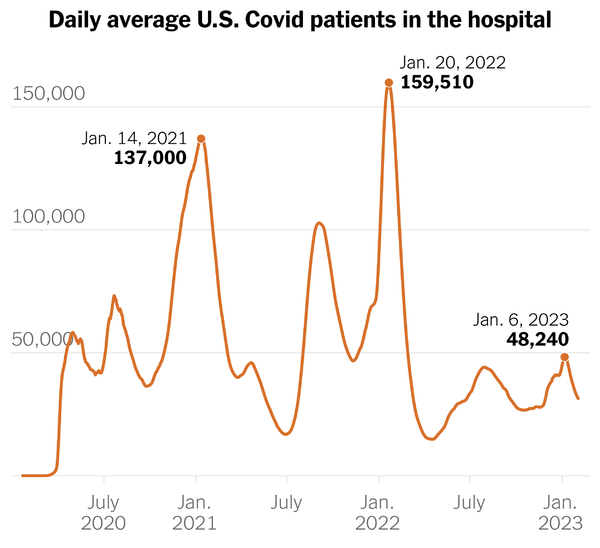Happy Presidents’ Day

The House of Representatives and the Senate are on District/State work breaks this week.
Govexec alerts us, “Labor Secretary Marty Walsh will be leaving the Biden administration in mid-March to become executive director of the National Hockey League Players’ Association.”
Federal News Network offers an update on implementing the Postal Service Health Benefits Program that takes effect on January 1, 2025. The article expresses concern about a tight timeline for implementation. The article does not consider OPM’s January 2023 decision to allow FEHB plans to offer Medicare Part D EGWPs in 2024. That welcome decision puts the new PSHBP and the existing FEHB on a similar footing.
While the new PSHBP will be more tightly integrated with Medicare Part B., the benefits of that phased in change will develop over time. For example, although the Postal Services will offer a one-time, penalty-free Part B Special Open Enrollment Period next year for annuitants over 65 who did not elect Part B, early retirees under 65 and active employees over age 64 on January 1, 2025, will be exempt from the PSHBP’s mandatory Part B election requirement.
In other FEHB news, AHIP has made available a topic overview for the March 29 – 30 OPM AHIP FEHB Carrier Conference.
In OPM news, Meritalk breaks down last week’s inaugural DEIA Annual Report from OPM’s Office of Diversity, Equity, Inclusion, and Accessibility (ODEIA).
From the Omicron and siblings front, the Wall Street Journal and Fierce Healthcare report on the Covid death rate. The Journal points out, “Deaths caused by Covid are heavily concentrated among the elderly, an analysis of CDC data shows. In recent weeks people 75 years and older have represented about seven of every 10 Covid-19 deaths.” Fierce Healthcare provides this perspective:
The JAMA Network Open study concluded that “COVID-19 due to the Omicron variant was associated with a higher risk of in-hospital mortality compared with patients with influenza. This indicates that the SARS-CoV-2 Omicron variant should still be taken seriously, and improved prevention and treatment strategies are still highly relevant, although overburdening of the health care system has become less likely over time.”
Fortune Well tells us about the importance of cardiac care following even a mild case of Covid.
In a bid to determine why and how COVID can affect the heart, Dr. Andrew Marks, a cardiologist and biophysics professor at Columbia University, and Steven Reiken, a research scientist in his lab, studied heart tissue from people who died of COVID, in addition to the hearts of mice that had been infected with COVID.
Among their findings, which they’ll present Monday at the 67th Annual Biophysical Society Meeting in San Diego:
- Heart tissue from humans shows increased levels of oxidative stress and inflammation, and changes in calcium levels due to damage to the system that regulates them in the heart. Such alterations can lead to arrhythmia or heart failure, according to the researchers.
- Chest pain and tachycardia, or an unusually fast heartbeat, are common long-term among COVID survivors.
- Heart tissue from mice shows an increased percentage of fibrosis and dilation of fibers—a common signal of early cardiomyopathy, which makes it more difficult for the heart to pump blood and can result in heart failure.
- The death of heart cells and blood clots in the hearts of mice who had been infected with COVID-19 were also observed.
“Doctors should be aware of heart changes related to COVID-19 infections and should be looking for them,” Marks says. He hopes his research leads to increased awareness among medical providers of the virus’s potentially stealthy cardiac fallout—and, eventually, treatments for those whose hearts have been damaged by the pathogen.
MedPage Today adds
People who took the antiviral Paxlovid to treat COVID-19 infections were not more likely to get back-to-back bouts of the virus, a new study shows.
The findings offer clarity amid concerns that the use of Paxlovid, which works by stopping the spread of the virus in the body, increased the risk of COVID-19 rebound.
“Rebound is a re-emergence of symptoms and an uptick in viral load after a period of recovery,” the Center for Infectious Disease Research and Policy explained in a summary of the study.
Researchers found that patients who received Paxlovid, another antiviral called Lagevrio, or no antiviral medication had rebounds at similar rates, ranging from 4.5% to 6.6%.
From the medical research front, the Wall Street Journal reports
A fist that opened and shut. A once-limp arm that moved from her side. Two women whose strokes left them with partial paralysis for years saw life trickle back to their limbs when electric pulses were delivered to the back of their spinal cord as part of a pilot study.
Neurologists said the approach, reported Monday in the journal Nature Medicine, could be transformative for stroke survivors, many of whom have some arm impairment after the event.
“I think it is amazing,” said Helmi Lutsep, a neurologist at Oregon Health & Science University, who wasn’t involved with the study. “I think patients will be thrilled if this comes to fruition.”
The pilot study was convincing but it would take much larger studies and a decade or more to know if stroke patients generally could benefit, according to Nick Ward, a neurologist at the University College London who wasn’t involved with the study.
From the U.S. healthcare business front, the Wall Street Journal informs us why “Walgreens CEO Bets on Doctors Over Drugstores in Search for Growth; Rosalind Brewer is shifting the chain’s focus to medical clinics,” like Village MD.
The strategy is guided by Ms. Brewer’s belief that the nation’s second-largest drugstore chain is in a business that she says no longer works. Industry growth is chronically slow, she said. Meanwhile, a shortage of workers is further cutting into revenue because the chain has had to reduce pharmacy hours.







